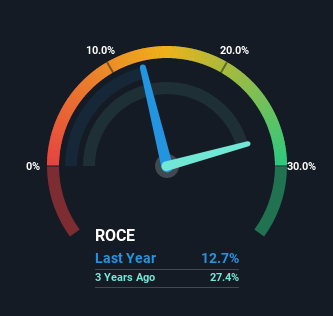Here's What's Concerning About Diwang Industrial Holdings' (HKG:1950) Returns On Capital

There are a few key trends to look for if we want to identify the next multi-bagger. Firstly, we'll want to see a proven return on capital employed (ROCE) that is increasing, and secondly, an expanding base of capital employed. If you see this, it typically means it's a company with a great business model and plenty of profitable reinvestment opportunities. Although, when we looked at Diwang Industrial Holdings (HKG:1950), it didn't seem to tick all of these boxes.
Return On Capital Employed (ROCE): What Is It?
For those who don't know, ROCE is a measure of a company's yearly pre-tax profit (its return), relative to the capital employed in the business. The formula for this calculation on Diwang Industrial Holdings is:
Return on Capital Employed = Earnings Before Interest and Tax (EBIT) ÷ (Total Assets - Current Liabilities)
0.13 = CN¥36m ÷ (CN¥347m - CN¥67m) (Based on the trailing twelve months to June 2022).
So, Diwang Industrial Holdings has an ROCE of 13%. That's a relatively normal return on capital, and it's around the 12% generated by the Chemicals industry.
Check out the opportunities and risks within the HK Chemicals industry.

While the past is not representative of the future, it can be helpful to know how a company has performed historically, which is why we have this chart above. If you want to delve into the historical earnings, revenue and cash flow of Diwang Industrial Holdings, check out these free graphs here.
What Does the ROCE Trend For Diwang Industrial Holdings Tell Us?
When we looked at the ROCE trend at Diwang Industrial Holdings, we didn't gain much confidence. Over the last five years, returns on capital have decreased to 13% from 20% five years ago. Although, given both revenue and the amount of assets employed in the business have increased, it could suggest the company is investing in growth, and the extra capital has led to a short-term reduction in ROCE. And if the increased capital generates additional returns, the business, and thus shareholders, will benefit in the long run.
On a related note, Diwang Industrial Holdings has decreased its current liabilities to 19% of total assets. So we could link some of this to the decrease in ROCE. Effectively this means their suppliers or short-term creditors are funding less of the business, which reduces some elements of risk. Some would claim this reduces the business' efficiency at generating ROCE since it is now funding more of the operations with its own money.
What We Can Learn From Diwang Industrial Holdings' ROCE
While returns have fallen for Diwang Industrial Holdings in recent times, we're encouraged to see that sales are growing and that the business is reinvesting in its operations. These growth trends haven't led to growth returns though, since the stock has fallen 27% over the last year. So we think it'd be worthwhile to look further into this stock given the trends look encouraging.
Diwang Industrial Holdings does come with some risks though, we found 4 warning signs in our investment analysis, and 1 of those is a bit concerning...
For those who like to invest in solid companies, check out this free list of companies with solid balance sheets and high returns on equity.
If you're looking to trade Diwang Industrial Holdings, open an account with the lowest-cost platform trusted by professionals, Interactive Brokers.
With clients in over 200 countries and territories, and access to 160 markets, IBKR lets you trade stocks, options, futures, forex, bonds and funds from a single integrated account.
Enjoy no hidden fees, no account minimums, and FX conversion rates as low as 0.03%, far better than what most brokers offer.
Sponsored ContentNew: Manage All Your Stock Portfolios in One Place
We've created the ultimate portfolio companion for stock investors, and it's free.
• Connect an unlimited number of Portfolios and see your total in one currency
• Be alerted to new Warning Signs or Risks via email or mobile
• Track the Fair Value of your stocks
Have feedback on this article? Concerned about the content? Get in touch with us directly. Alternatively, email editorial-team (at) simplywallst.com.
This article by Simply Wall St is general in nature. We provide commentary based on historical data and analyst forecasts only using an unbiased methodology and our articles are not intended to be financial advice. It does not constitute a recommendation to buy or sell any stock, and does not take account of your objectives, or your financial situation. We aim to bring you long-term focused analysis driven by fundamental data. Note that our analysis may not factor in the latest price-sensitive company announcements or qualitative material. Simply Wall St has no position in any stocks mentioned.
About SEHK:1950
Diwang Industrial Holdings
An investment holding company, engages in the research and development, manufacture, and sale of coating agents and synthetic resins in the People’s Republic of China, Mexico, Turkey, and Vietnam.
Flawless balance sheet with solid track record.
Market Insights
Community Narratives



